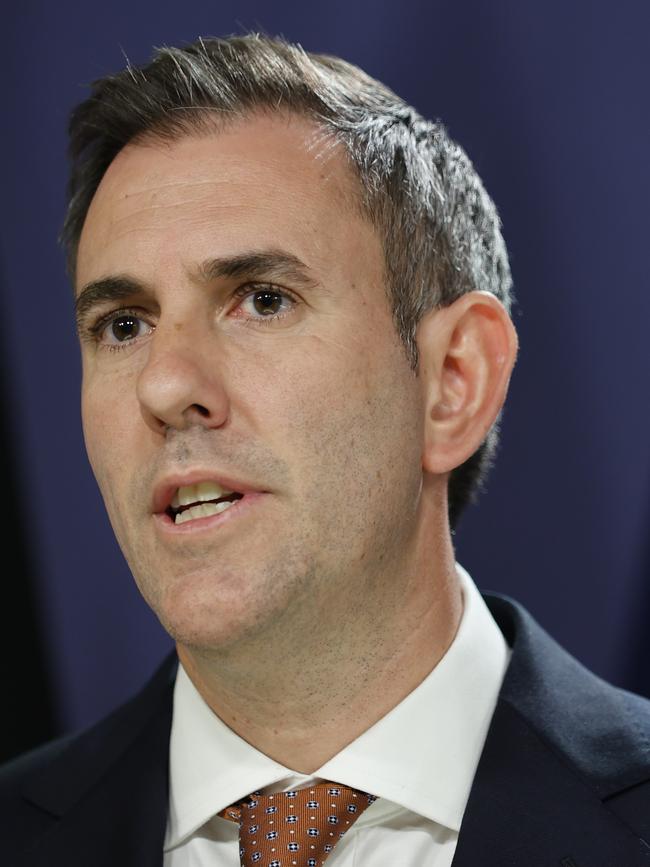Labor’s dilemma: how to finance its compassion
Anthony Albanese and Jim Chalmers have to reconcile the irreconcilable. The PM poses as Mr Compassion, Mr National Security and Mr Budget Responsibility. It’s too good to be true.

In recent days Anthony Albanese has issued two personal declarations – on the defence front saying Australia “confronts the most challenging strategic circumstances since the second world war” and on the personal compassion front saying he knows people are “under real pressure” because he was raised in the household reliant on an invalid pensioner mother.
Public policy has a sharper edge when decisions are seen in moral and personal terms. The Prime Minister, who helped to destroy Scott Morrison on character grounds, knows that judgments on priorities will determine the character of his government and his own standing.
Albanese and Jim Chalmers are about to earn their pay grade. They have to reconcile the irreconcilable. The budget numbers don’t fit Labor’s political model and the pressures it faces. Albanese poses as Mr Compassion, Mr National Security and Mr Budget Responsibility. It’s too good to be true. The long-run structural budget deficit will tear this political trifecta apart.
This week the Defence Strategic Review – cast as the most important strategic rethink for 80 years – produced a blueprint that saw Defence Minister Richard Marles affirm the need for long-run growth over the decade in defence spending beyond the 2 per cent of GDP benchmark. The uplift will need to hit 2.5 per cent at the minimum.
This followed a report from the Economic Inclusion Advisory Committee, chaired by former ALP minister Jenny Macklin, advising on the budget around income support and disadvantage. Its chief recommendation was an “immediate” and “substantial” increase in JobSeeker and related payments, found to be “seriously inadequate” and costing $24bn across the four years of forward estimates to lift JobSeeker to the target of 90 per cent of the Age Pension.
The Treasurer understandably played down expectations. “While we can’t fund every good idea, there will be measures in the May budget to address disadvantage,” he said. “This will include energy bill price relief that prioritises those on payments and pensions.”
It was a statement of the obvious but what was once obvious is being reinvented. A single person on JobSeeker receives up to $347 a week or $49.50 a day compared with a single pensioner on about $500 a week, with the gap having blown out enormously across two decades. The case for action is strong and the backlash was wide and deep. It came not just from the crossbench but also within the Labor caucus, with this newspaper reporting on Friday as many as 12 ALP backbenchers have joined the revolt for a JobSeeker increase. A letter was dispatched to Albanese signed not just by the welfare lobby but also by economists, influential women and community and business leaders.
Chalmers, of course, was asked the gotcha question – could he live on $49.50 a day? Under pressure, he said it was his job as Treasurer “to weigh up all the competing demands” and that Labor would protect the vulnerable.

It was a reminder that Marles, despite releasing a report calling for urgent action, an end to business as usual and outlining the most dangerous strategic circumstances facing the country in decades, had been unable to secure extra defence funds across the four years of forward estimates, having to settle instead for funding reallocations.
Labor is locked in an agonising dilemma. It talks up its ambition. It parades its values. It espouses its compassion. It wants an aged-care revolution. It pledges nuclear-powered submarines. It promises to look after numerous constituencies. It commissions report after report – but it disappoints at the delivery point.
The pressure is building – Labor is trapped between its political needs and its budget. The budget cannot meet the exploding needs of the country and Labor ambition. This was apparent a year ago; it is more apparent now. The Grattan Institute, the think tank that carries weight with the government, released this month an action plan seeking to bust the structural deadlock.
The report under Grattan chief executive Danielle Wood recommends over years spending reduction options of about $15bn and increased revenue options of well over $50bn. The report says the current structural gap between revenue and spending will reach about 3 per cent of GDP in a decade. That’s untenable. Indeed, it’s untenable now. “We are not a high-taxing country by OECD standards,” Wood and Iris Chan wrote. “You don’t get BMW services on a Kia budget.”
-
“Labor is locked in an agonising dilemma. It talks up its ambition. It parades its values. It espouses its compassion. It wants an aged-care revolution. It pledges nuclear-powered submarines.”
-
The message is: get real about raising taxes to pay for what people want. Become a bold government, not a middle-of-the-road incremental government. Understand you must become a fully progressive government, move left and sell the idea of selective increases in taxation. The assumption, highly dubious, is that the public will come on board.
But the budget in 10 days comes amid slowing growth, stubbornly high inflation and a serious structural deficit problem. Don’t be fooled because inflation has peaked. It runs through the services economy and more interest rates rises will be needed.
Meanwhile, on the compassion front Albanese accepts the need – sure to be presented in moral terms – to lift the age eligibility for the single parenting payment from eight years to about 13 or 14 years, reversing a Gillard government decision. JobSeeker is a far bigger ask and tougher given that the labour market is tight and the electoral dividends from such action would be extremely limited.
How much can the budget carry? In truth, it will be carrying a lot: the big-spending areas, long nominated by Chalmers, eat up the revenues: the National Disability Insurance Scheme, interest payments on debt, hospitals, aged care, defence and Medicare. The energy price relief comes in addition.
But there’s a fiscal optical illusion in the budget as explained by independent economist Chris Richardson: “Basically, inflation takes money from families and hands it to governments.” Inflation sees people struggling on negative real wages and inadequate benefits, but high inflation is good for governments owning debt because they repay in depreciated dollars and in Australia’s case high commodity prices drive a revenue surge.
Richardson says: “My specific estimate – and it will change before budget night because the economy keeps moving – is a boost to revenues of $96bn over the four years to 2025-26 over and above that in the official estimates from October. By the way, JobKeeper cost $89bn. So you’d have thought that a casual bend-down-and-pick-it-up $96bn extra in the tax take from Treasury underestimating the size of the economy might have received a little more attention than it has to date.
“The lucky country has had two amazingly lucky treasurers – Peter Costello and (to date at least) Chalmers. Both presided over conditions that threw money at the tax man. And, of the two, it’s Lucky Chalmers in the lead by a mile.
“The bottom line is the economy hasn’t been this kind to government finances for a century and a half in Australia.”
Richardson says the budget at present “is pretty close to balance”. Even more remarkable, he calculates that net debt as a proportion of GDP is the same today as it was before the pandemic hit. And that is “stunning”. He says that despite all the talk about a “trillion-dollar debt” that net debt is currently about half that – at $538bn.
What does this mean? It is great news and a terrible trap.
The great news is temporary revenues. The trap is to take long-range decisions based on commodity-induced revenues that will disappear. The bottom line in this budget will look good but, Richardson says, “there’s some bad news around and it’s permanent”.
The bad news lies in the spending locomotives that generate an annual structural deficit in the vicinity of $50bn. This structural deficit is permanent and will outlive the current commodity price boom. While Richardson and Wood don’t agree on the exact number of this structural deficit, they do agree on its broad dimensions, its permanence and on the need for it to be addressed.
But when and how?
These are the economic and political question that haunt Chalmers and Albanese. Labor is trying to square the circle. It is reluctant to break more promises. It is easy for backbencher to demand more welfare spending but backbenchers don’t have the job of living with the consequences. Do they want a budget that leaves the tasking of fighting inflation to the Reserve Bank? That won’t do. Do they want the government to pivot to the Grattan strategy and embrace a new agenda of taxation increases? Maybe some do.
The fiscal predicament means the ultimate need for spending restraint and tax reform cannot be postponed indefinitely. Richardson tells Inquirer: “If they don’t take decisions in this budget and do the brave things, then that’s it. We are in the run-up to the next election after that.”
The logic of the parliamentary term means the coming budget constitutes the time for hard and brave decisions. Presumably, this is the budget that determines the first-term character of the Albanese government.
The risks are it will disappoint. Is the true nature of Albanese and Chalmers that they are Labor moderates? If so, that’s understandable, it’s a function of past history and Labor’s narrow majority. They know reform is needed but their preference is for gradual reform, not bold leaps.
But Albanese and Chalmers know the political threat comes from the left – the unions, the welfare lobby, the crossbenchers, the Greens and the long progressive log of claims based on justice and compassion. The politics are diabolical. The coming will be seen as defining not just Labor priorities but its values.
The Grattan report identifies the big trends. As countries get richer, citizen expectations of government services increase – witness the NDIS and aged care. This is reinforced by the power of demography and an ageing population. In addition, most services provided by government are labour-intensive and that means they cost more across time. Finally, external forces from security threats to climate change impose even greater obligations on governments. There is no retreat to the past.
The story is revenues haven’t kept pace with spending demands and the Grattan report nominates a range of tax options – winding back income tax concessions, redesigning the stage three tax cuts, increasing the GST, better taxation of fossil fuels. “We would not expect the government to move on all these changes at once but the menu includes choices worth about $50bn a year once mature,” the report says.
It says government payments as a share of the economy have historically averaged about 25 per cent of GDP but this is projected to rise to 27 per cent of GDP. In truth, the era of bigger government was introduced under the former Coalition government and Labor is merely building on the trend.
Richardson has floated his own suggestions for tax reform including trimming the stage three tax cuts by keeping the 37 per cent rate, reworking the petroleum resources rent tax, increasing the bank liabilities tax, dropping the capital gains tax discount from 50 per cent to 33 per cent, and keeping the superannuation guarantee rate at 10.5 per cent.
He has highlighted the imperative for NDIS reform. National cabinet moved on this front on Friday putting an annual 8 per cent growth target on NDIS funding. The utility of the target depends upon political willpower and federal-state co-operation. At present, the incentives are wrong. Cost control is weak and profits in the NDIS service provider sector rose more than 29 per cent on average every year since 2018.
Richardson says the situation at present is “the NDIS is on track to fail both the disabled and taxpayers” – a double failure at a huge cost.
Chalmers deserves credit for retaining the policy of phasing out the low and middle income tax offset, the initial phase of the former government’s tax reform agenda. At a cost of $11bn the decision means low and middle-income taxpayers will face an income hit. Maintaining the tax offset in the current inflation climate would have been a mistake and only put further upward pressure on interest rates. Chalmers has stuck by the right economic decision but Labor will have to live with the political consequences.
Regardless of the Albanese-Chalmers decision on JobSeeker, the pressures will not abate. The economic inclusion committee says all the evidence reveals the payment levels are seriously inadequate and have fallen to such a low level that “they create a barrier to paid work” since people “are not having enough money to meet the essentials of life”.
In a wider sense, the committee wants pledges on economic inclusion and poverty reduction incorporated in legislation, agreement on targets and the tracking of progress. It wants the development of a multidimensional poverty index to support legislated measures. It wants the Treasurer responsible for the setting of targets and achieving their implementation.








Priorities define governments and the Albanese government now faces a network of competing priorities – witness the need to re-shape and finance the Australian Defence Force to combat China’s threat and the pressure to lift the inadequate JobSeeker unemployment payment for more than one million people.